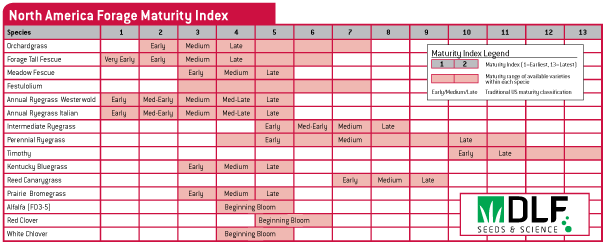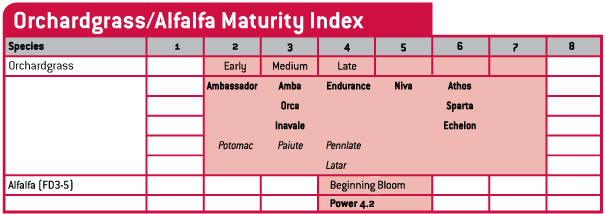Forage Maturity Index
Challenge:
As forage grasses and legumes approach reproductive maturity, DM accumulation increases, however forage quality decreases. Because of development by forage breeders to broaden maturity ranges, the traditional nomenclature of early, medium, and late is no longer effective in classifying and comparing the relative reproductive maturity of varieties within a species. A producer attempting to select a correct variety for his/her operation is challenged to compare the maturity of varieties among different forage grass companies.
Additional challenges arise when comparing reproductive maturity between species. Interspecies correlation is lacking. An “early maturity” variety in one species may actually be chronologically later in maturity than a “late maturity” variety in another species. Selecting for maturity in a monoculture, or even a two species mix, is relatively easy compared to synchronizing maturities in a diverse polyculture forage system. A better tool to describe variety maturity is needed.
Solution:
In an effort to standardize maturity classifications, DLF has initiated the Northern American Forage Maturity Index for forage grasses in North America. This initiative has been adopted by the American Forage & Grassland Council in 2015. In collaboration with other forage breeders, a protocol is developed and an extensive trial is set up in three different climate zones to determine the relative maturity of 70 varieties spread over 8 species. These varieties will populate the initial Forage Maturity Index and serve as indicator varieties for future varieties to be rated for an FMI.
Data will be collected from the trial in 2017 and 2018. That will allow for an initial launch of the Forage Maturity Index in the spring of 2019.
How it will Look:
In the example below the Forage Maturity Index has a 13-point index with a maturity difference of approximately 5 days per unit, reflecting Oregon conditions (the final FMI may have a wider range with fewer days/unit). Variance may occur in different regions, since some cultivars are more temperature dependent, while others may be more day length dependent for transition to the generative phase, determining maturity.
 With all species using the same Maturity Index Rating System, the maturity range of various forage species can now be directly compared on the same chronological maturity index (the grey index scale at the top of the table). The red blocks in the index reflect the maturity range of available varieties within the species. The respective maturity of public varieties using the traditional nomenclature of early/medium/late is superimposed on the index. At species level, this can be expanded; the available varieties can be indicated at the proper maturity index. A maturity index in one species corresponds to the same maturity in another forage species.
With all species using the same Maturity Index Rating System, the maturity range of various forage species can now be directly compared on the same chronological maturity index (the grey index scale at the top of the table). The red blocks in the index reflect the maturity range of available varieties within the species. The respective maturity of public varieties using the traditional nomenclature of early/medium/late is superimposed on the index. At species level, this can be expanded; the available varieties can be indicated at the proper maturity index. A maturity index in one species corresponds to the same maturity in another forage species.
Utilization:
Within the structure of the Forage Maturity Index, individual species can be indexed and compared. Orchardgrass (Dactylis glomerata) is a species with significant confusion. Orchardgrass is traditionally classified as early, medium, and late. Public varieties corresponding to these classifications include Potomac as early, Paiute as a medium, and both Latar and Pennlate as late. This traditional classification does not appreciate the work of European, US, and Canadian orchardgrass breeders who have extended the maturity range by more than two maturity index steps. What one forage company may list as a “medium” maturity in their variety line-up may match the maturity of a “late” in the traditional classification.
 When alfalfa and orchardgrass are planted in the same field, optimization for DM yield and forage quality requires coordination of the maturity range and cutting regime for the two forage components. The Forage Maturity Index facilitates the recommendation of the correct varieties.
When alfalfa and orchardgrass are planted in the same field, optimization for DM yield and forage quality requires coordination of the maturity range and cutting regime for the two forage components. The Forage Maturity Index facilitates the recommendation of the correct varieties.
Festulolium varieties are “hybrids” between a ryegrass as one parent and a meadow fescue, or a tall fescue, as the other parent. It results in a spread in maturities. The traditional US maturity classification for festulolium is linked to the more dominant parent. Utilizing the Forage Maturity Index clearly ranks the maturity of festulolium varieties within the species. Utilizing the Forage Maturity Index illustrates that a “medium” maturity ryegrass type festulolium is actually later in maturity than a “late” maturity tall fescue type.

